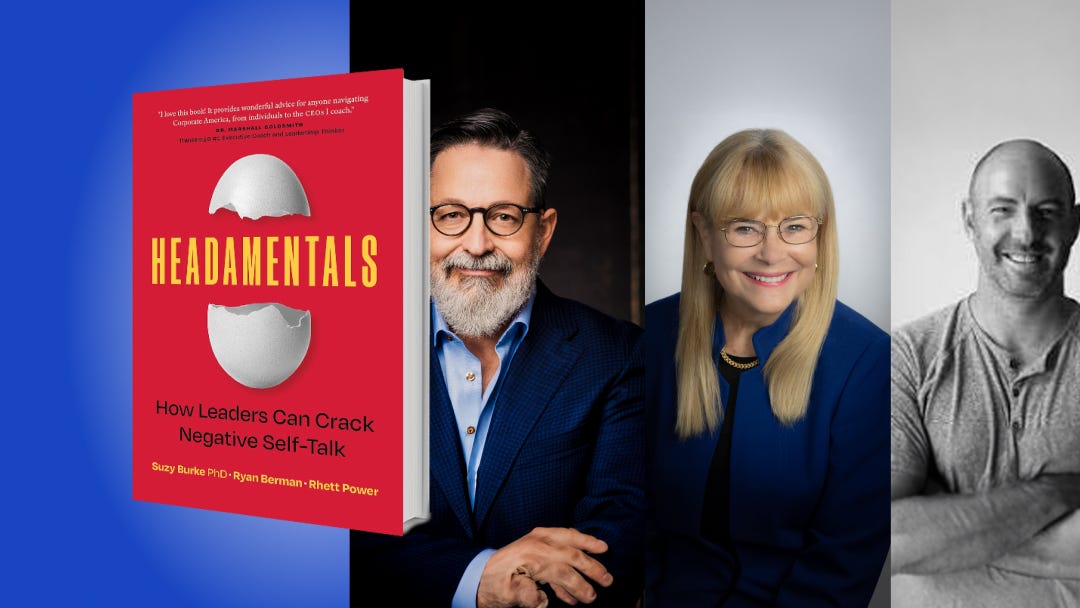Silence the Monster: How to Stop Negative Self-Talk from Running Your Team
The hardest part of leadership isn’t strategy—it’s the story you tell yourself. These experts reveal how to rewrite that inner script and lead with clarity, confidence, and calm.
Listen now on Spotify or Apple Podcasts:
Every leader knows that as tough as it can be to manage others, the real challenge is managing yourself —your insecurities, your bad habits, your distracted thoughts. That’s why corporate consultants Suzy Burke, Ryan Berman and have written a new book called Headamentals: How Leaders Can Crack Negative Self-Talk that offers guidance for that most important workplace of all — the one inside your head. Read on for five of their key insights.
1. Self-talk is the hidden saboteur of leadership.
We’ve always had societal-scale worry wars, but we like to refer to the pandemic as Worry War I. Now we are in Worry War II, which confronts the rising cost of food, the emergence of AI, the erosion of empathy at work, and political division.
If Worry War I was the pandemic, fueled by isolation and fears of illness, then Worry War II is pandemonium. It is all these forces—pushing us, nudging us, spiraling us out—and each of us is dealing with it in our own way. Layer on top of that the things we told ourselves as kids, what our parents might’ve said, which have stuck in our minds. You start to see why we’re spiraling and where our self-talk comes from. Think of that voice inside your head: Where does yours come from? That voice triggers how you show up in different situations.
Sometimes a self-talk spiral is triggered by what’s happening in the world right now, like when you try to watch the news. Or other times, even as an older adult, your self-talk can spiral when something reminds you of a challenging experience or feeling from your childhood. Self-talk, unbeknownst to those around you, can spiral out of control and become a hidden force holding back yourself and your teams.
2. Every leader has a monster.
The hardest part of being a leader isn’t the market pressure. It’s not the late nights, the impossible deadlines, or even your fiercest competitor. The hardest part is the voice in your head that makes you rewrite an email at midnight because of how it might land, pause before you speak (even when you’re the expert in the room), and turns every compliment into a question mark. This voice is the one that whispers, or sometimes roars, that you don’t belong.
That voice doesn’t just shape your day, it shapes everything. It determines whether you share your thoughts in that high-stakes meeting or let the moment pass; whether you inspire confidence or let doubt leak into the room; whether your team feels a calm, steady presence or the weight of uncertainty. It shapes the culture your team breathes every single day. What gets celebrated, what gets overlooked, and what never gets said out loud.
“Your self-talk becomes team talk.”
If you want a team that’s bold, resilient, and innovative, it doesn’t start with your strategy. It doesn’t start with your offsite. It starts with a conversation happening in your head—that’s your monster. And almost every leader has one. What matters is whether this voice is left in charge, because when your monster speaks, your team listens. Your self-talk becomes team talk.
According to the National Science Foundation, we have up to 60,000 thoughts a day: 80 percent of them are negative, and 95 percent are repetitive. That’s 48,000 mental reruns of doubt every single day. Given that reality, it is no surprise that most of us wrestle with imposter syndrome: 62 percent worldwide, 71 percent in the U.S. If you’re a high achiever, that percentage is even greater.
Albert Einstein, one of the greatest scientific minds in history, once confessed that he felt like an involuntary swindler. The man who reshaped our understanding of the universe worried that he was faking it. Sonia Sotomayor, the first Hispanic Supreme Court Justice, has also admitted to feeling like a fraud. She once said in a speech, “I’m always looking over my shoulder, wondering if I measure up.” And Howard Schultz, former CEO of Starbucks, admits that very few people get into the CEO seat and truly believe they belong. If Einstein can doubt his brain, Sotomayor can doubt her success, and Schultz can doubt his right to the corner office, then self-doubt isn’t a glitch. It’s the default. Your monster doesn’t care about your resume, titles, or trophies.
Get a Signed Copy of Brené Brown’s Latest
If you’re not yet a Next Big Idea Club member, now is a perfect time to join. You’ll get:
• Exclusive access to our guided discussions and live Q&A sessions with the authors and curators.
• A vibrant community of fellow readers for connection and shared insights, including a NEW private WhatsApp group.
• Thousands of audio “Book Bites” and bonus materials to enhance your reading experience through the Next Big Idea app.
• New hardcover members will receive signed copies of Strong Ground.
3. Your mindset isn’t fixed.
Your mindset is programmable, and you are the programmer. To program it, it’s important to understand why we’re plagued by our monsters in the first place. The answer is evolution. Our brains are wired for survival, not growth. Our brain’s default mode fixates on past threats to help us avoid future danger. If you were laughed at for speaking up in class, your brain filed that away so that now, when you’re thinking about speaking up in a meeting, that same voice might whisper don’t. If your first boss pounced on every small slip, your inner critic learned that imperfection equals incompetence. Years later, it still sounds the alarm.
“Don’t try to ignore your monster.”
Conventional wisdom says to cast your inner critic as a bully and either ignore, suppress, or conquer it. But our monsters are trying to protect us, not destroy us. The moment you step outside of what’s familiar—giving tough feedback, launching a bold idea, taking on a new role—you invite risk and vulnerability. That’s when your monster pipes up, saying, What if you fail? But staying safe trades impact for comfort and progress for predictability. The irony is that true psychological safety doesn’t come from avoiding risks, but rather from knowing that you can take them and still be okay. Don’t try to ignore your monster. Get curious about it.
The 3-C Maverick Method as a tool for reframing negative self-talk in real time: Catch, Confront, Change. When you think about something, it shapes how you feel about it, which in turn shapes how you act. When you recreate the story you tell yourself, you change the outcome. If you see setbacks as invitations to grow, then feedback stops feeling like criticism and begins building confidence. That’s the power of changing the conversation in your head. You often can’t control what happens to you, but you can control how you think about it and respond. This is the essence of cognitive reframing and our antidote to negative self-talk, and the cornerstone of our three-step method:
Catch yourself when your mind is saying you’re not smart or tough enough to succeed. Your emotions are an alarm system. Anxiety is often the first indicator that the monster is moving in. Tune in, identify the counterproductive thought.
Confront that thought. Challenge your monster with facts that prove it wrong.
Change the narrative by reframing the story your monster is telling you.
4. There is more than one type of monster.
Sports coaches say you practice 95 percent of the time for the 5 percent of the time that you actually play. In business, it is almost entirely the opposite. Think about how long the orientation phase is as a company: you’re given an hour of orientation to find out where you’re supposed to go, and then practice is over. But we need more practice, specifically for retraining the brain to have stronger tools for dealing with self-talk.
There are five monster archetypes holding us back that we need to practice dealing with. We call these cognitive distortions CAMOS, because they camouflage or conceal your truth:
Catastrophizer – assumes the worst will happen, even if it probably won’t.
Always Righter – needs to be right, no matter what.
Mind Reader – tries to tell you what you’re thinking, before you even know what that is.
Over-generalizer – takes one bad thing and paints everything with it.
Should-er – lives by unrealistic “should” and “musts,” creating unnecessary pressure.
5. Self-talk can be your leadership plutonium.
All leaders eventually discover that self-talk is their most powerful, volatile energy source. It can fuel extraordinary growth or cause quiet, invisible damage. Every day, there’s a voice running in your head—evaluating, judging, predicting, doubting, encouraging—and it never stops. As a leader or founder, that voice becomes the unseen soundtrack for your company.
We tend to think of our thoughts as private, but they’re not. They leak out in our body language, decisions, energy, and how we communicate. When a founder walks into a room and he’s full of stress, teams don’t just hear it; they feel it. If your self-talk is full of fear, your team starts to operate out of fear. If your self-talk is reactive, your team becomes reactive. But if your self-talk is grounded in belief and clarity, then your team learns to respond the same way. You can’t create a calm, confident, accountable team if you’re running around with a chaotic inner dialogue.
Culture starts with what you say to yourself in those private moments before the big decision, before the investor pitch, or before the tough conversation. Leaders who have built billion-dollar companies share the quality of disciplined thinking. They don’t let the wrong stories take root. They challenge their own narratives and are intentional about what they say to themselves because they know it shapes how they show up for everyone else.
Plutonium, like the power of self-talk, can power cities or destroy them. The teams that are winning are not just on the same page strategically, but are also on the same page emotionally and mentally. They’ve built shared language and a rhythm of confidence and clarity that amplifies everyone’s performance. That alignment is leadership plutonium. When your self-talk and your team’s talk are synced, you’ve created an unstoppable force.




